How to Invest in Lithium: A Comprehensive Guide
VerifiedAdded on 2023/01/19
|14
|3943
|84
AI Summary
This article provides a comprehensive guide on how to invest in lithium. It discusses the factors driving the lithium boom, the different forms of lithium, and the most profitable investment options, such as mining companies and lithium ETFs.
Contribute Materials
Your contribution can guide someone’s learning journey. Share your
documents today.
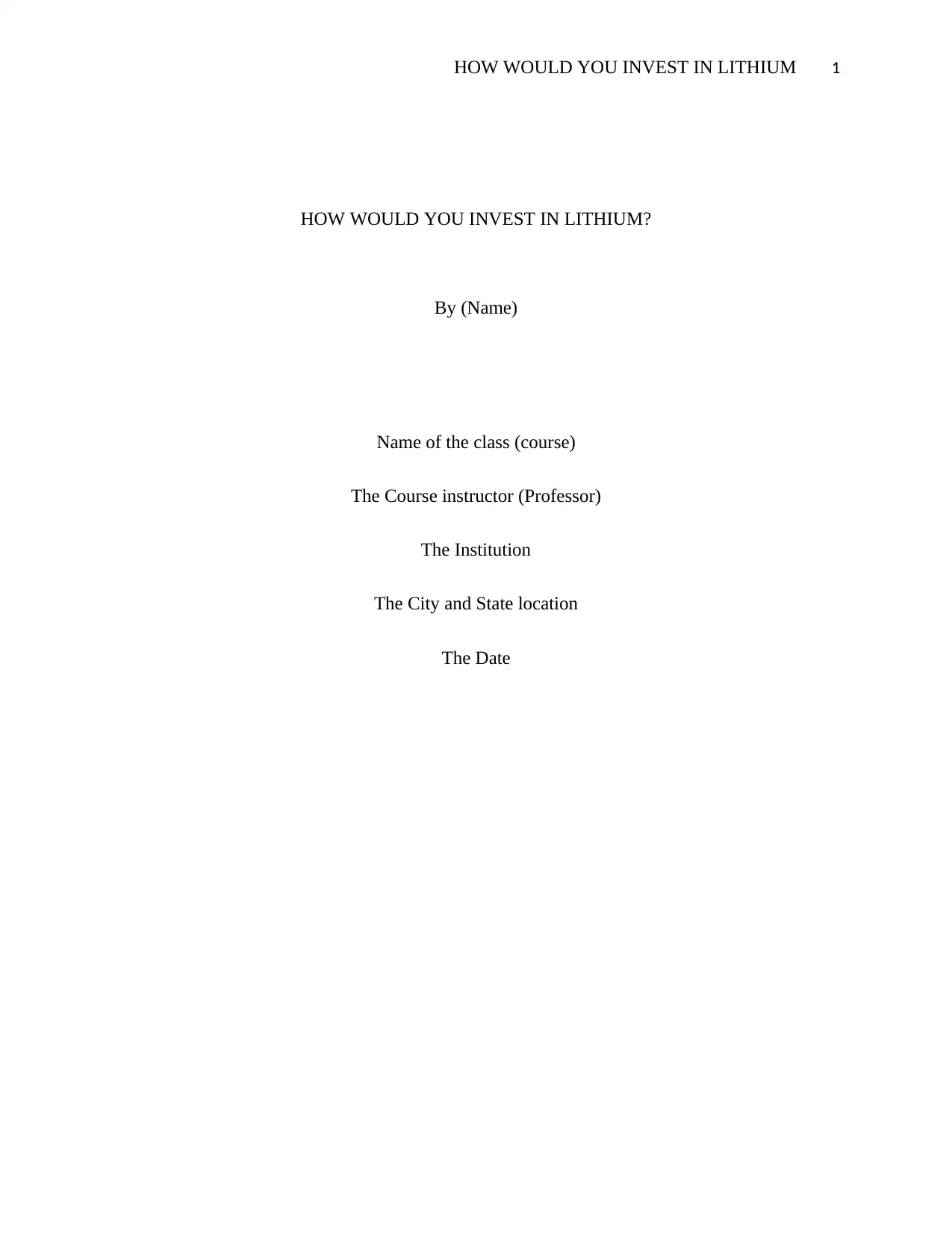
HOW WOULD YOU INVEST IN LITHIUM 1
HOW WOULD YOU INVEST IN LITHIUM?
By (Name)
Name of the class (course)
The Course instructor (Professor)
The Institution
The City and State location
The Date
HOW WOULD YOU INVEST IN LITHIUM?
By (Name)
Name of the class (course)
The Course instructor (Professor)
The Institution
The City and State location
The Date
Secure Best Marks with AI Grader
Need help grading? Try our AI Grader for instant feedback on your assignments.
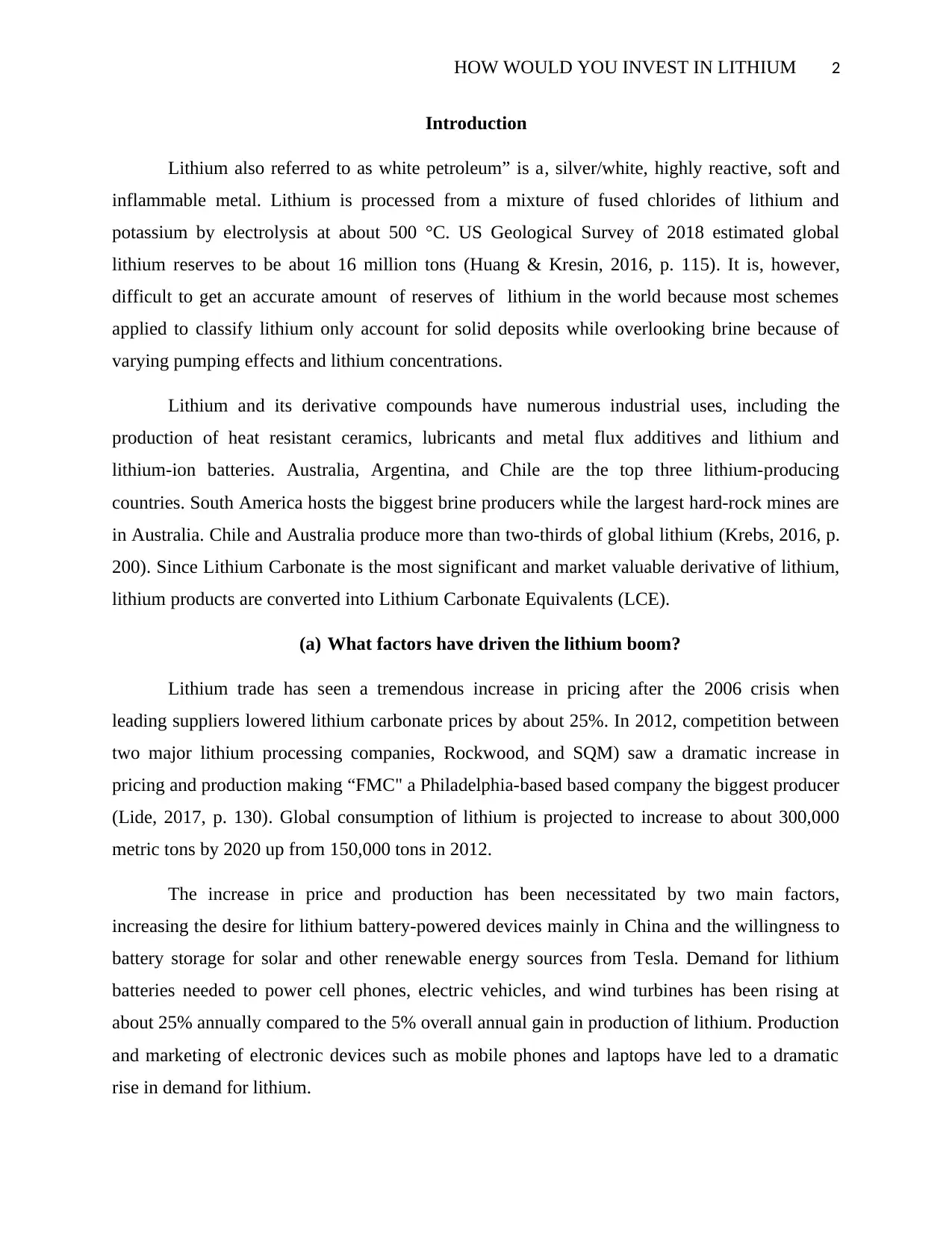
HOW WOULD YOU INVEST IN LITHIUM 2
Introduction
Lithium also referred to as white petroleum” is a, silver/white, highly reactive, soft and
inflammable metal. Lithium is processed from a mixture of fused chlorides of lithium and
potassium by electrolysis at about 500 °C. US Geological Survey of 2018 estimated global
lithium reserves to be about 16 million tons (Huang & Kresin, 2016, p. 115). It is, however,
difficult to get an accurate amount of reserves of lithium in the world because most schemes
applied to classify lithium only account for solid deposits while overlooking brine because of
varying pumping effects and lithium concentrations.
Lithium and its derivative compounds have numerous industrial uses, including the
production of heat resistant ceramics, lubricants and metal flux additives and lithium and
lithium-ion batteries. Australia, Argentina, and Chile are the top three lithium-producing
countries. South America hosts the biggest brine producers while the largest hard-rock mines are
in Australia. Chile and Australia produce more than two-thirds of global lithium (Krebs, 2016, p.
200). Since Lithium Carbonate is the most significant and market valuable derivative of lithium,
lithium products are converted into Lithium Carbonate Equivalents (LCE).
(a) What factors have driven the lithium boom?
Lithium trade has seen a tremendous increase in pricing after the 2006 crisis when
leading suppliers lowered lithium carbonate prices by about 25%. In 2012, competition between
two major lithium processing companies, Rockwood, and SQM) saw a dramatic increase in
pricing and production making “FMC" a Philadelphia-based based company the biggest producer
(Lide, 2017, p. 130). Global consumption of lithium is projected to increase to about 300,000
metric tons by 2020 up from 150,000 tons in 2012.
The increase in price and production has been necessitated by two main factors,
increasing the desire for lithium battery-powered devices mainly in China and the willingness to
battery storage for solar and other renewable energy sources from Tesla. Demand for lithium
batteries needed to power cell phones, electric vehicles, and wind turbines has been rising at
about 25% annually compared to the 5% overall annual gain in production of lithium. Production
and marketing of electronic devices such as mobile phones and laptops have led to a dramatic
rise in demand for lithium.
Introduction
Lithium also referred to as white petroleum” is a, silver/white, highly reactive, soft and
inflammable metal. Lithium is processed from a mixture of fused chlorides of lithium and
potassium by electrolysis at about 500 °C. US Geological Survey of 2018 estimated global
lithium reserves to be about 16 million tons (Huang & Kresin, 2016, p. 115). It is, however,
difficult to get an accurate amount of reserves of lithium in the world because most schemes
applied to classify lithium only account for solid deposits while overlooking brine because of
varying pumping effects and lithium concentrations.
Lithium and its derivative compounds have numerous industrial uses, including the
production of heat resistant ceramics, lubricants and metal flux additives and lithium and
lithium-ion batteries. Australia, Argentina, and Chile are the top three lithium-producing
countries. South America hosts the biggest brine producers while the largest hard-rock mines are
in Australia. Chile and Australia produce more than two-thirds of global lithium (Krebs, 2016, p.
200). Since Lithium Carbonate is the most significant and market valuable derivative of lithium,
lithium products are converted into Lithium Carbonate Equivalents (LCE).
(a) What factors have driven the lithium boom?
Lithium trade has seen a tremendous increase in pricing after the 2006 crisis when
leading suppliers lowered lithium carbonate prices by about 25%. In 2012, competition between
two major lithium processing companies, Rockwood, and SQM) saw a dramatic increase in
pricing and production making “FMC" a Philadelphia-based based company the biggest producer
(Lide, 2017, p. 130). Global consumption of lithium is projected to increase to about 300,000
metric tons by 2020 up from 150,000 tons in 2012.
The increase in price and production has been necessitated by two main factors,
increasing the desire for lithium battery-powered devices mainly in China and the willingness to
battery storage for solar and other renewable energy sources from Tesla. Demand for lithium
batteries needed to power cell phones, electric vehicles, and wind turbines has been rising at
about 25% annually compared to the 5% overall annual gain in production of lithium. Production
and marketing of electronic devices such as mobile phones and laptops have led to a dramatic
rise in demand for lithium.
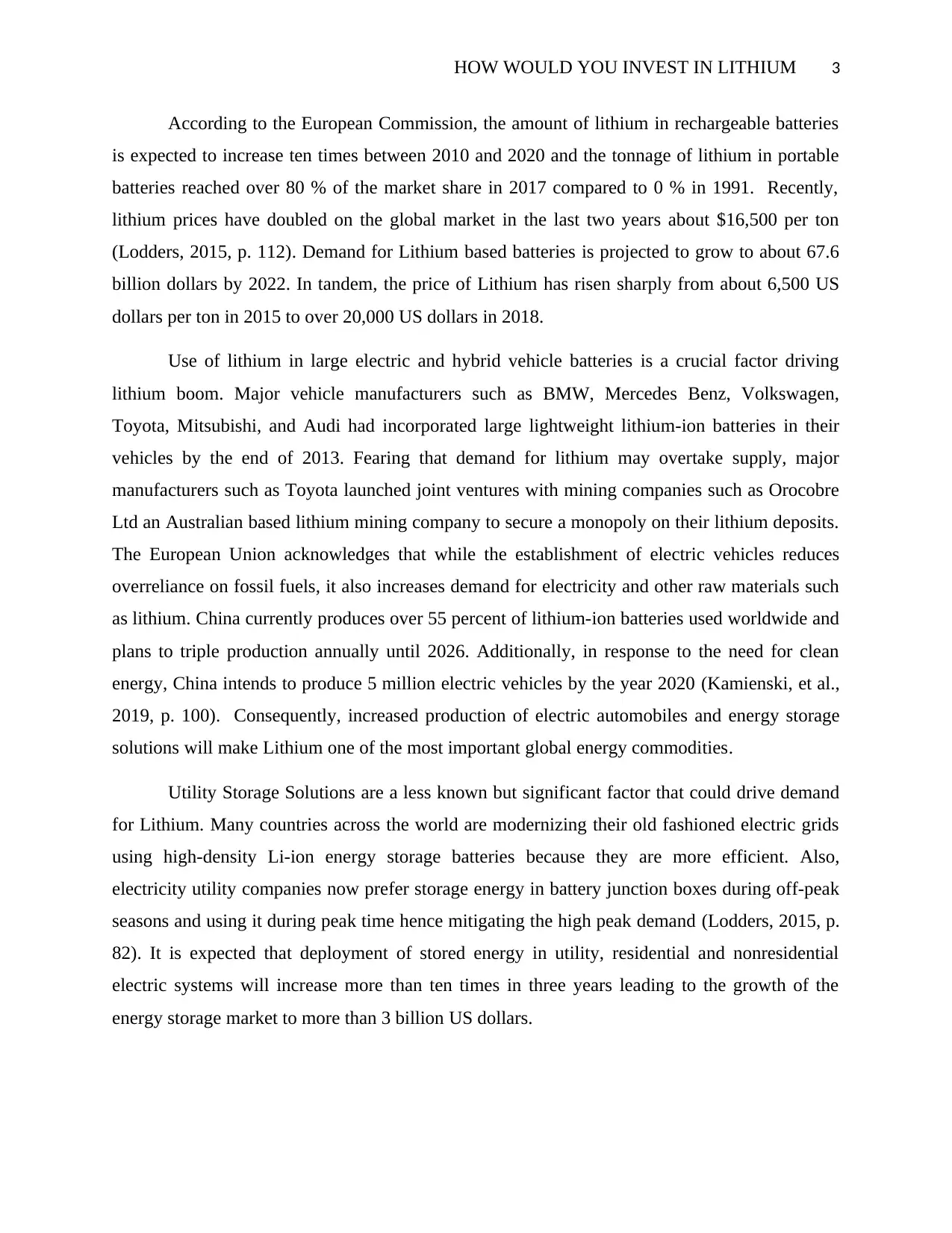
HOW WOULD YOU INVEST IN LITHIUM 3
According to the European Commission, the amount of lithium in rechargeable batteries
is expected to increase ten times between 2010 and 2020 and the tonnage of lithium in portable
batteries reached over 80 % of the market share in 2017 compared to 0 % in 1991. Recently,
lithium prices have doubled on the global market in the last two years about $16,500 per ton
(Lodders, 2015, p. 112). Demand for Lithium based batteries is projected to grow to about 67.6
billion dollars by 2022. In tandem, the price of Lithium has risen sharply from about 6,500 US
dollars per ton in 2015 to over 20,000 US dollars in 2018.
Use of lithium in large electric and hybrid vehicle batteries is a crucial factor driving
lithium boom. Major vehicle manufacturers such as BMW, Mercedes Benz, Volkswagen,
Toyota, Mitsubishi, and Audi had incorporated large lightweight lithium-ion batteries in their
vehicles by the end of 2013. Fearing that demand for lithium may overtake supply, major
manufacturers such as Toyota launched joint ventures with mining companies such as Orocobre
Ltd an Australian based lithium mining company to secure a monopoly on their lithium deposits.
The European Union acknowledges that while the establishment of electric vehicles reduces
overreliance on fossil fuels, it also increases demand for electricity and other raw materials such
as lithium. China currently produces over 55 percent of lithium-ion batteries used worldwide and
plans to triple production annually until 2026. Additionally, in response to the need for clean
energy, China intends to produce 5 million electric vehicles by the year 2020 (Kamienski, et al.,
2019, p. 100). Consequently, increased production of electric automobiles and energy storage
solutions will make Lithium one of the most important global energy commodities.
Utility Storage Solutions are a less known but significant factor that could drive demand
for Lithium. Many countries across the world are modernizing their old fashioned electric grids
using high-density Li-ion energy storage batteries because they are more efficient. Also,
electricity utility companies now prefer storage energy in battery junction boxes during off-peak
seasons and using it during peak time hence mitigating the high peak demand (Lodders, 2015, p.
82). It is expected that deployment of stored energy in utility, residential and nonresidential
electric systems will increase more than ten times in three years leading to the growth of the
energy storage market to more than 3 billion US dollars.
According to the European Commission, the amount of lithium in rechargeable batteries
is expected to increase ten times between 2010 and 2020 and the tonnage of lithium in portable
batteries reached over 80 % of the market share in 2017 compared to 0 % in 1991. Recently,
lithium prices have doubled on the global market in the last two years about $16,500 per ton
(Lodders, 2015, p. 112). Demand for Lithium based batteries is projected to grow to about 67.6
billion dollars by 2022. In tandem, the price of Lithium has risen sharply from about 6,500 US
dollars per ton in 2015 to over 20,000 US dollars in 2018.
Use of lithium in large electric and hybrid vehicle batteries is a crucial factor driving
lithium boom. Major vehicle manufacturers such as BMW, Mercedes Benz, Volkswagen,
Toyota, Mitsubishi, and Audi had incorporated large lightweight lithium-ion batteries in their
vehicles by the end of 2013. Fearing that demand for lithium may overtake supply, major
manufacturers such as Toyota launched joint ventures with mining companies such as Orocobre
Ltd an Australian based lithium mining company to secure a monopoly on their lithium deposits.
The European Union acknowledges that while the establishment of electric vehicles reduces
overreliance on fossil fuels, it also increases demand for electricity and other raw materials such
as lithium. China currently produces over 55 percent of lithium-ion batteries used worldwide and
plans to triple production annually until 2026. Additionally, in response to the need for clean
energy, China intends to produce 5 million electric vehicles by the year 2020 (Kamienski, et al.,
2019, p. 100). Consequently, increased production of electric automobiles and energy storage
solutions will make Lithium one of the most important global energy commodities.
Utility Storage Solutions are a less known but significant factor that could drive demand
for Lithium. Many countries across the world are modernizing their old fashioned electric grids
using high-density Li-ion energy storage batteries because they are more efficient. Also,
electricity utility companies now prefer storage energy in battery junction boxes during off-peak
seasons and using it during peak time hence mitigating the high peak demand (Lodders, 2015, p.
82). It is expected that deployment of stored energy in utility, residential and nonresidential
electric systems will increase more than ten times in three years leading to the growth of the
energy storage market to more than 3 billion US dollars.
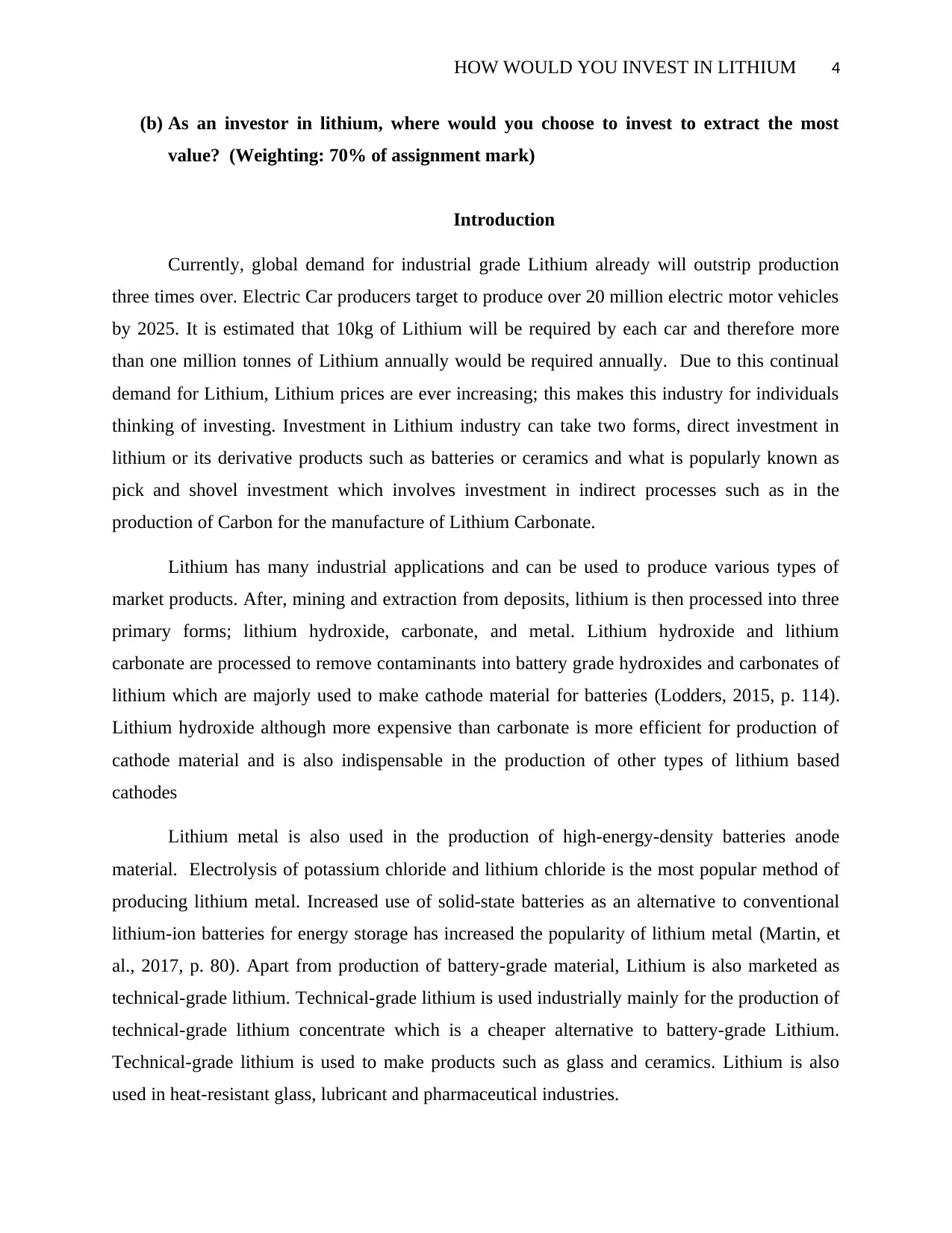
HOW WOULD YOU INVEST IN LITHIUM 4
(b) As an investor in lithium, where would you choose to invest to extract the most
value? (Weighting: 70% of assignment mark)
Introduction
Currently, global demand for industrial grade Lithium already will outstrip production
three times over. Electric Car producers target to produce over 20 million electric motor vehicles
by 2025. It is estimated that 10kg of Lithium will be required by each car and therefore more
than one million tonnes of Lithium annually would be required annually. Due to this continual
demand for Lithium, Lithium prices are ever increasing; this makes this industry for individuals
thinking of investing. Investment in Lithium industry can take two forms, direct investment in
lithium or its derivative products such as batteries or ceramics and what is popularly known as
pick and shovel investment which involves investment in indirect processes such as in the
production of Carbon for the manufacture of Lithium Carbonate.
Lithium has many industrial applications and can be used to produce various types of
market products. After, mining and extraction from deposits, lithium is then processed into three
primary forms; lithium hydroxide, carbonate, and metal. Lithium hydroxide and lithium
carbonate are processed to remove contaminants into battery grade hydroxides and carbonates of
lithium which are majorly used to make cathode material for batteries (Lodders, 2015, p. 114).
Lithium hydroxide although more expensive than carbonate is more efficient for production of
cathode material and is also indispensable in the production of other types of lithium based
cathodes
Lithium metal is also used in the production of high-energy-density batteries anode
material. Electrolysis of potassium chloride and lithium chloride is the most popular method of
producing lithium metal. Increased use of solid-state batteries as an alternative to conventional
lithium-ion batteries for energy storage has increased the popularity of lithium metal (Martin, et
al., 2017, p. 80). Apart from production of battery-grade material, Lithium is also marketed as
technical-grade lithium. Technical-grade lithium is used industrially mainly for the production of
technical-grade lithium concentrate which is a cheaper alternative to battery-grade Lithium.
Technical-grade lithium is used to make products such as glass and ceramics. Lithium is also
used in heat-resistant glass, lubricant and pharmaceutical industries.
(b) As an investor in lithium, where would you choose to invest to extract the most
value? (Weighting: 70% of assignment mark)
Introduction
Currently, global demand for industrial grade Lithium already will outstrip production
three times over. Electric Car producers target to produce over 20 million electric motor vehicles
by 2025. It is estimated that 10kg of Lithium will be required by each car and therefore more
than one million tonnes of Lithium annually would be required annually. Due to this continual
demand for Lithium, Lithium prices are ever increasing; this makes this industry for individuals
thinking of investing. Investment in Lithium industry can take two forms, direct investment in
lithium or its derivative products such as batteries or ceramics and what is popularly known as
pick and shovel investment which involves investment in indirect processes such as in the
production of Carbon for the manufacture of Lithium Carbonate.
Lithium has many industrial applications and can be used to produce various types of
market products. After, mining and extraction from deposits, lithium is then processed into three
primary forms; lithium hydroxide, carbonate, and metal. Lithium hydroxide and lithium
carbonate are processed to remove contaminants into battery grade hydroxides and carbonates of
lithium which are majorly used to make cathode material for batteries (Lodders, 2015, p. 114).
Lithium hydroxide although more expensive than carbonate is more efficient for production of
cathode material and is also indispensable in the production of other types of lithium based
cathodes
Lithium metal is also used in the production of high-energy-density batteries anode
material. Electrolysis of potassium chloride and lithium chloride is the most popular method of
producing lithium metal. Increased use of solid-state batteries as an alternative to conventional
lithium-ion batteries for energy storage has increased the popularity of lithium metal (Martin, et
al., 2017, p. 80). Apart from production of battery-grade material, Lithium is also marketed as
technical-grade lithium. Technical-grade lithium is used industrially mainly for the production of
technical-grade lithium concentrate which is a cheaper alternative to battery-grade Lithium.
Technical-grade lithium is used to make products such as glass and ceramics. Lithium is also
used in heat-resistant glass, lubricant and pharmaceutical industries.
Secure Best Marks with AI Grader
Need help grading? Try our AI Grader for instant feedback on your assignments.
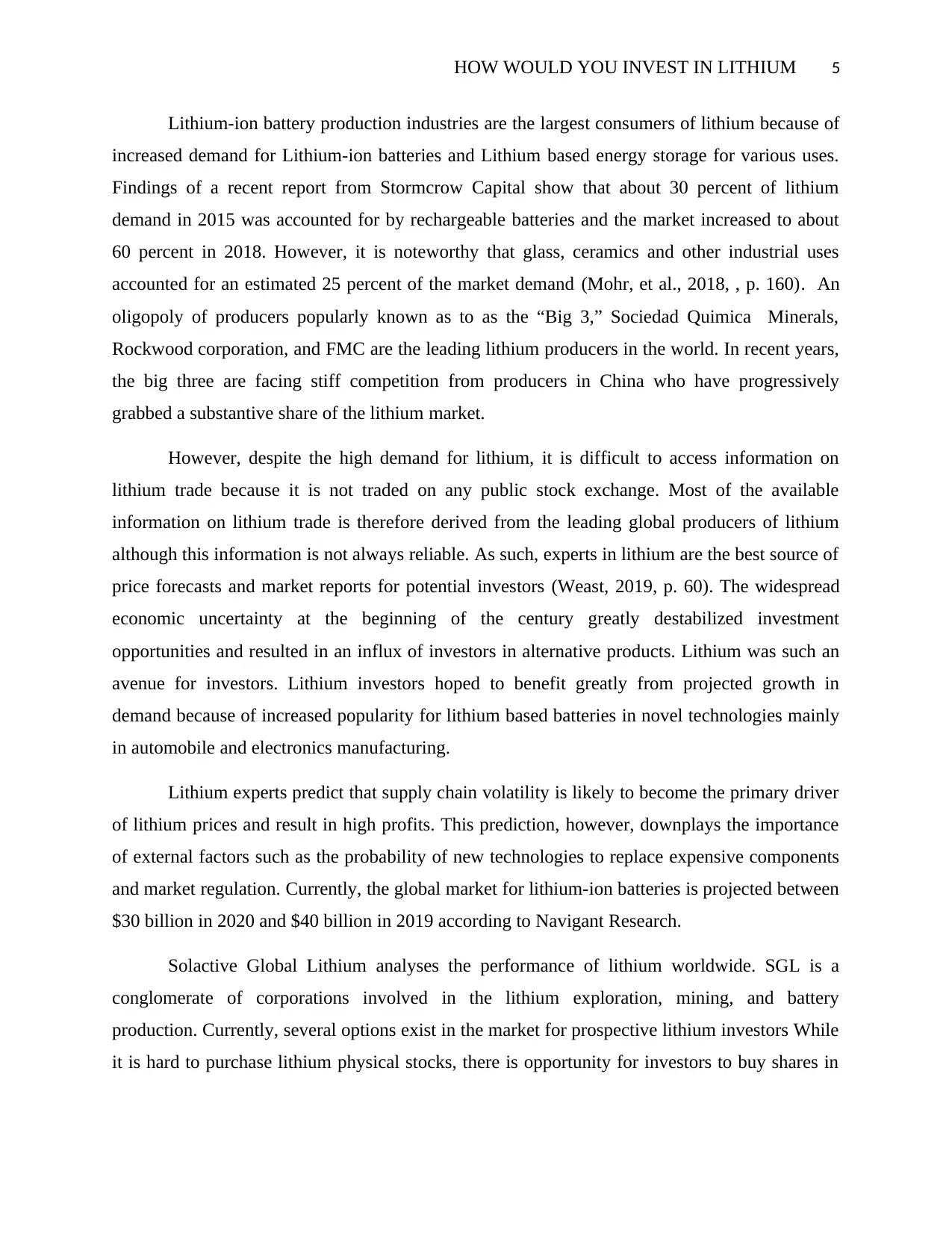
HOW WOULD YOU INVEST IN LITHIUM 5
Lithium-ion battery production industries are the largest consumers of lithium because of
increased demand for Lithium-ion batteries and Lithium based energy storage for various uses.
Findings of a recent report from Stormcrow Capital show that about 30 percent of lithium
demand in 2015 was accounted for by rechargeable batteries and the market increased to about
60 percent in 2018. However, it is noteworthy that glass, ceramics and other industrial uses
accounted for an estimated 25 percent of the market demand (Mohr, et al., 2018, , p. 160). An
oligopoly of producers popularly known as to as the “Big 3,” Sociedad Quimica Minerals,
Rockwood corporation, and FMC are the leading lithium producers in the world. In recent years,
the big three are facing stiff competition from producers in China who have progressively
grabbed a substantive share of the lithium market.
However, despite the high demand for lithium, it is difficult to access information on
lithium trade because it is not traded on any public stock exchange. Most of the available
information on lithium trade is therefore derived from the leading global producers of lithium
although this information is not always reliable. As such, experts in lithium are the best source of
price forecasts and market reports for potential investors (Weast, 2019, p. 60). The widespread
economic uncertainty at the beginning of the century greatly destabilized investment
opportunities and resulted in an influx of investors in alternative products. Lithium was such an
avenue for investors. Lithium investors hoped to benefit greatly from projected growth in
demand because of increased popularity for lithium based batteries in novel technologies mainly
in automobile and electronics manufacturing.
Lithium experts predict that supply chain volatility is likely to become the primary driver
of lithium prices and result in high profits. This prediction, however, downplays the importance
of external factors such as the probability of new technologies to replace expensive components
and market regulation. Currently, the global market for lithium-ion batteries is projected between
$30 billion in 2020 and $40 billion in 2019 according to Navigant Research.
Solactive Global Lithium analyses the performance of lithium worldwide. SGL is a
conglomerate of corporations involved in the lithium exploration, mining, and battery
production. Currently, several options exist in the market for prospective lithium investors While
it is hard to purchase lithium physical stocks, there is opportunity for investors to buy shares in
Lithium-ion battery production industries are the largest consumers of lithium because of
increased demand for Lithium-ion batteries and Lithium based energy storage for various uses.
Findings of a recent report from Stormcrow Capital show that about 30 percent of lithium
demand in 2015 was accounted for by rechargeable batteries and the market increased to about
60 percent in 2018. However, it is noteworthy that glass, ceramics and other industrial uses
accounted for an estimated 25 percent of the market demand (Mohr, et al., 2018, , p. 160). An
oligopoly of producers popularly known as to as the “Big 3,” Sociedad Quimica Minerals,
Rockwood corporation, and FMC are the leading lithium producers in the world. In recent years,
the big three are facing stiff competition from producers in China who have progressively
grabbed a substantive share of the lithium market.
However, despite the high demand for lithium, it is difficult to access information on
lithium trade because it is not traded on any public stock exchange. Most of the available
information on lithium trade is therefore derived from the leading global producers of lithium
although this information is not always reliable. As such, experts in lithium are the best source of
price forecasts and market reports for potential investors (Weast, 2019, p. 60). The widespread
economic uncertainty at the beginning of the century greatly destabilized investment
opportunities and resulted in an influx of investors in alternative products. Lithium was such an
avenue for investors. Lithium investors hoped to benefit greatly from projected growth in
demand because of increased popularity for lithium based batteries in novel technologies mainly
in automobile and electronics manufacturing.
Lithium experts predict that supply chain volatility is likely to become the primary driver
of lithium prices and result in high profits. This prediction, however, downplays the importance
of external factors such as the probability of new technologies to replace expensive components
and market regulation. Currently, the global market for lithium-ion batteries is projected between
$30 billion in 2020 and $40 billion in 2019 according to Navigant Research.
Solactive Global Lithium analyses the performance of lithium worldwide. SGL is a
conglomerate of corporations involved in the lithium exploration, mining, and battery
production. Currently, several options exist in the market for prospective lithium investors While
it is hard to purchase lithium physical stocks, there is opportunity for investors to buy shares in

HOW WOULD YOU INVEST IN LITHIUM 6
companies that mine and process lithium. Below are some of the most profitable lithium
companies that may yield higher returns on investment.
Mining companies
Many companies are profitably involved in the mining of lithium, and they can form a good
source of investment. They include; Advantage Lithium, a large-scale lithium explorer located in
Canada and Argentina. Sociedad Minera, a producer of specialized chemicals located in the
Desert of Atacama. FMC industrial Corporation is an American based chemical company,
Albemarle Corp producing lithium chemicals, Bacanora corporation, a Canadian industry mining
lithium in Mexico (Kamienski, et al., 2019, p. 104). MGX corporation, a mining company that
mining petrol and lithium in the United States and Canada. Kodal Minerals is a lithium miner
that explores lithium in Mali.
i. Investment in Lithium Exchange Traded Funds
The Global X Lithium & Battery Tech Exchange-traded funds offer a direct and broader way
to invest in lithium. Global X Lithium ETF (NYSE: LIT) is an Exchange-traded fund established
in 2010 that specializes in the trading of lithium stocks. Global X Lithium ETF is the holding
company of all the major lithium producers in the world. As such it is a very lucrative and stable
avenue in which to invest. Lithium Exchange Traded Funds are lucrative avenues because they
offer an opportunity to invest in the full lithium cycle, from mining and exploration, refining, to
battery production. The fund aims to provide investment gains commensurate to the performance
of price and yield.
As of last year (2018), the company offers a dividend of nearly 3 percent per share, and it
boasts an annual performance of 0.47% since 2010 (Harmon, 2018, p. 58). In the same time,
company assets have grown from about $70 million to about $592 million in just three years.
ii. Supplier of Electric Cars
It is estimated that about 1.8 million new electric vehicles were sold in 2018 up from
virtually no cars at all ten years earlier. The International Energy Agency projects that nearly
12.9 million electric vehicles will be available in main world markets by 2022 and about 90
companies that mine and process lithium. Below are some of the most profitable lithium
companies that may yield higher returns on investment.
Mining companies
Many companies are profitably involved in the mining of lithium, and they can form a good
source of investment. They include; Advantage Lithium, a large-scale lithium explorer located in
Canada and Argentina. Sociedad Minera, a producer of specialized chemicals located in the
Desert of Atacama. FMC industrial Corporation is an American based chemical company,
Albemarle Corp producing lithium chemicals, Bacanora corporation, a Canadian industry mining
lithium in Mexico (Kamienski, et al., 2019, p. 104). MGX corporation, a mining company that
mining petrol and lithium in the United States and Canada. Kodal Minerals is a lithium miner
that explores lithium in Mali.
i. Investment in Lithium Exchange Traded Funds
The Global X Lithium & Battery Tech Exchange-traded funds offer a direct and broader way
to invest in lithium. Global X Lithium ETF (NYSE: LIT) is an Exchange-traded fund established
in 2010 that specializes in the trading of lithium stocks. Global X Lithium ETF is the holding
company of all the major lithium producers in the world. As such it is a very lucrative and stable
avenue in which to invest. Lithium Exchange Traded Funds are lucrative avenues because they
offer an opportunity to invest in the full lithium cycle, from mining and exploration, refining, to
battery production. The fund aims to provide investment gains commensurate to the performance
of price and yield.
As of last year (2018), the company offers a dividend of nearly 3 percent per share, and it
boasts an annual performance of 0.47% since 2010 (Harmon, 2018, p. 58). In the same time,
company assets have grown from about $70 million to about $592 million in just three years.
ii. Supplier of Electric Cars
It is estimated that about 1.8 million new electric vehicles were sold in 2018 up from
virtually no cars at all ten years earlier. The International Energy Agency projects that nearly
12.9 million electric vehicles will be available in main world markets by 2022 and about 90

HOW WOULD YOU INVEST IN LITHIUM 7
million will be driven in 2040. Bloomberg’s New Energy Finance group targets that by 2025,
more than 10 million electric vehicles will be sold annually.
Figure 1: Source: Katusa, 2018.
There is a generational paradigm shift from gasoline-electric powered evidenced by
unprecedented growth the U.S. electric car company Tesla to an equal market capital as motor
vehicle giants such as Ford and General Motors (Kalevi, et al., 2018, p. 32)
i. Supply of Electric vehicle batteries
Lithium batteries are increasingly becoming preferred alternative sources of power for high
energy- reliant technologies because of their efficiency and scalability when compared to nickel-
metal hydride batteries. There was a 40% increase in the number of new electrical vehicles sold
globally from 2017 to 2018 with more than estimated 1.7 million cars sold that year, and
Bloomberg projects that 8 million vehicles will be sold in 2025 and over 45 million by 2035.
Thus there is enormous demand from major automotive technology leaders for electric vehicle
batteries (Arwedson, 2018, p. 97).
Common Electric car batteries used by major automotive industries such as Tesla and
BYD are either composed of lithium combined with Cobalt, Nickel and Manganese or Lithium
million will be driven in 2040. Bloomberg’s New Energy Finance group targets that by 2025,
more than 10 million electric vehicles will be sold annually.
Figure 1: Source: Katusa, 2018.
There is a generational paradigm shift from gasoline-electric powered evidenced by
unprecedented growth the U.S. electric car company Tesla to an equal market capital as motor
vehicle giants such as Ford and General Motors (Kalevi, et al., 2018, p. 32)
i. Supply of Electric vehicle batteries
Lithium batteries are increasingly becoming preferred alternative sources of power for high
energy- reliant technologies because of their efficiency and scalability when compared to nickel-
metal hydride batteries. There was a 40% increase in the number of new electrical vehicles sold
globally from 2017 to 2018 with more than estimated 1.7 million cars sold that year, and
Bloomberg projects that 8 million vehicles will be sold in 2025 and over 45 million by 2035.
Thus there is enormous demand from major automotive technology leaders for electric vehicle
batteries (Arwedson, 2018, p. 97).
Common Electric car batteries used by major automotive industries such as Tesla and
BYD are either composed of lithium combined with Cobalt, Nickel and Manganese or Lithium
Paraphrase This Document
Need a fresh take? Get an instant paraphrase of this document with our AI Paraphraser
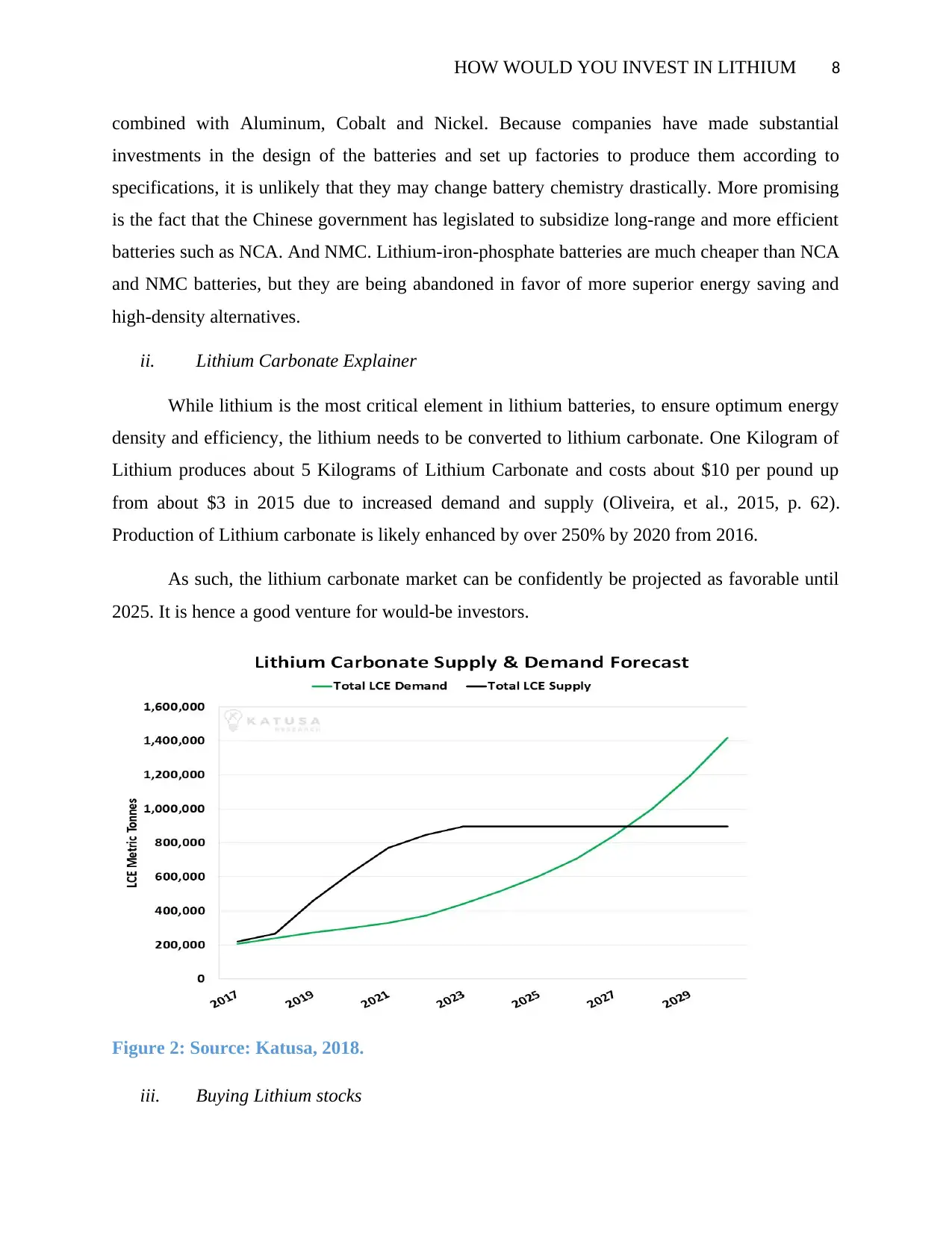
HOW WOULD YOU INVEST IN LITHIUM 8
combined with Aluminum, Cobalt and Nickel. Because companies have made substantial
investments in the design of the batteries and set up factories to produce them according to
specifications, it is unlikely that they may change battery chemistry drastically. More promising
is the fact that the Chinese government has legislated to subsidize long-range and more efficient
batteries such as NCA. And NMC. Lithium-iron-phosphate batteries are much cheaper than NCA
and NMC batteries, but they are being abandoned in favor of more superior energy saving and
high-density alternatives.
ii. Lithium Carbonate Explainer
While lithium is the most critical element in lithium batteries, to ensure optimum energy
density and efficiency, the lithium needs to be converted to lithium carbonate. One Kilogram of
Lithium produces about 5 Kilograms of Lithium Carbonate and costs about $10 per pound up
from about $3 in 2015 due to increased demand and supply (Oliveira, et al., 2015, p. 62).
Production of Lithium carbonate is likely enhanced by over 250% by 2020 from 2016.
As such, the lithium carbonate market can be confidently be projected as favorable until
2025. It is hence a good venture for would-be investors.
Figure 2: Source: Katusa, 2018.
iii. Buying Lithium stocks
combined with Aluminum, Cobalt and Nickel. Because companies have made substantial
investments in the design of the batteries and set up factories to produce them according to
specifications, it is unlikely that they may change battery chemistry drastically. More promising
is the fact that the Chinese government has legislated to subsidize long-range and more efficient
batteries such as NCA. And NMC. Lithium-iron-phosphate batteries are much cheaper than NCA
and NMC batteries, but they are being abandoned in favor of more superior energy saving and
high-density alternatives.
ii. Lithium Carbonate Explainer
While lithium is the most critical element in lithium batteries, to ensure optimum energy
density and efficiency, the lithium needs to be converted to lithium carbonate. One Kilogram of
Lithium produces about 5 Kilograms of Lithium Carbonate and costs about $10 per pound up
from about $3 in 2015 due to increased demand and supply (Oliveira, et al., 2015, p. 62).
Production of Lithium carbonate is likely enhanced by over 250% by 2020 from 2016.
As such, the lithium carbonate market can be confidently be projected as favorable until
2025. It is hence a good venture for would-be investors.
Figure 2: Source: Katusa, 2018.
iii. Buying Lithium stocks
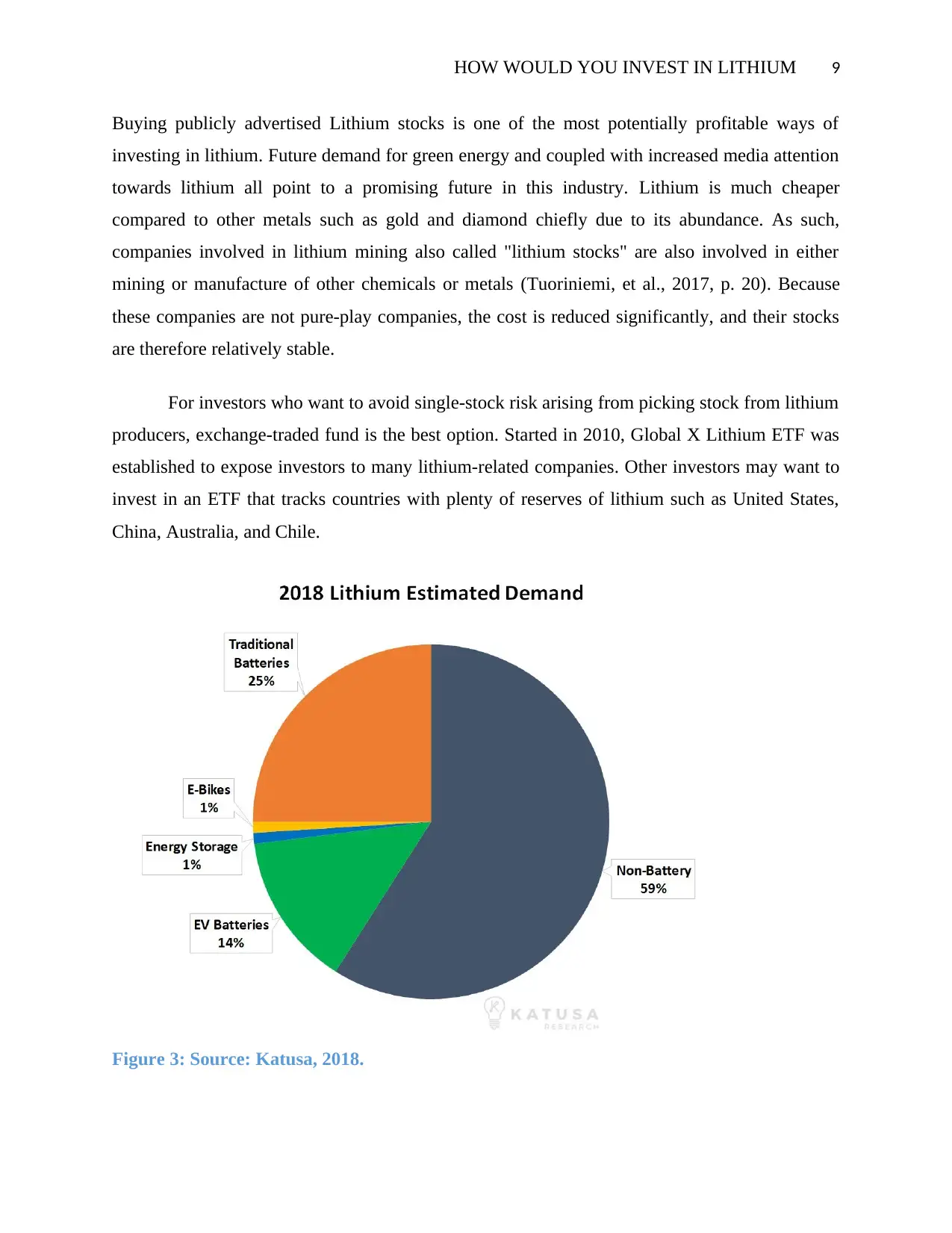
HOW WOULD YOU INVEST IN LITHIUM 9
Buying publicly advertised Lithium stocks is one of the most potentially profitable ways of
investing in lithium. Future demand for green energy and coupled with increased media attention
towards lithium all point to a promising future in this industry. Lithium is much cheaper
compared to other metals such as gold and diamond chiefly due to its abundance. As such,
companies involved in lithium mining also called "lithium stocks" are also involved in either
mining or manufacture of other chemicals or metals (Tuoriniemi, et al., 2017, p. 20). Because
these companies are not pure-play companies, the cost is reduced significantly, and their stocks
are therefore relatively stable.
For investors who want to avoid single-stock risk arising from picking stock from lithium
producers, exchange-traded fund is the best option. Started in 2010, Global X Lithium ETF was
established to expose investors to many lithium-related companies. Other investors may want to
invest in an ETF that tracks countries with plenty of reserves of lithium such as United States,
China, Australia, and Chile.
Figure 3: Source: Katusa, 2018.
Buying publicly advertised Lithium stocks is one of the most potentially profitable ways of
investing in lithium. Future demand for green energy and coupled with increased media attention
towards lithium all point to a promising future in this industry. Lithium is much cheaper
compared to other metals such as gold and diamond chiefly due to its abundance. As such,
companies involved in lithium mining also called "lithium stocks" are also involved in either
mining or manufacture of other chemicals or metals (Tuoriniemi, et al., 2017, p. 20). Because
these companies are not pure-play companies, the cost is reduced significantly, and their stocks
are therefore relatively stable.
For investors who want to avoid single-stock risk arising from picking stock from lithium
producers, exchange-traded fund is the best option. Started in 2010, Global X Lithium ETF was
established to expose investors to many lithium-related companies. Other investors may want to
invest in an ETF that tracks countries with plenty of reserves of lithium such as United States,
China, Australia, and Chile.
Figure 3: Source: Katusa, 2018.
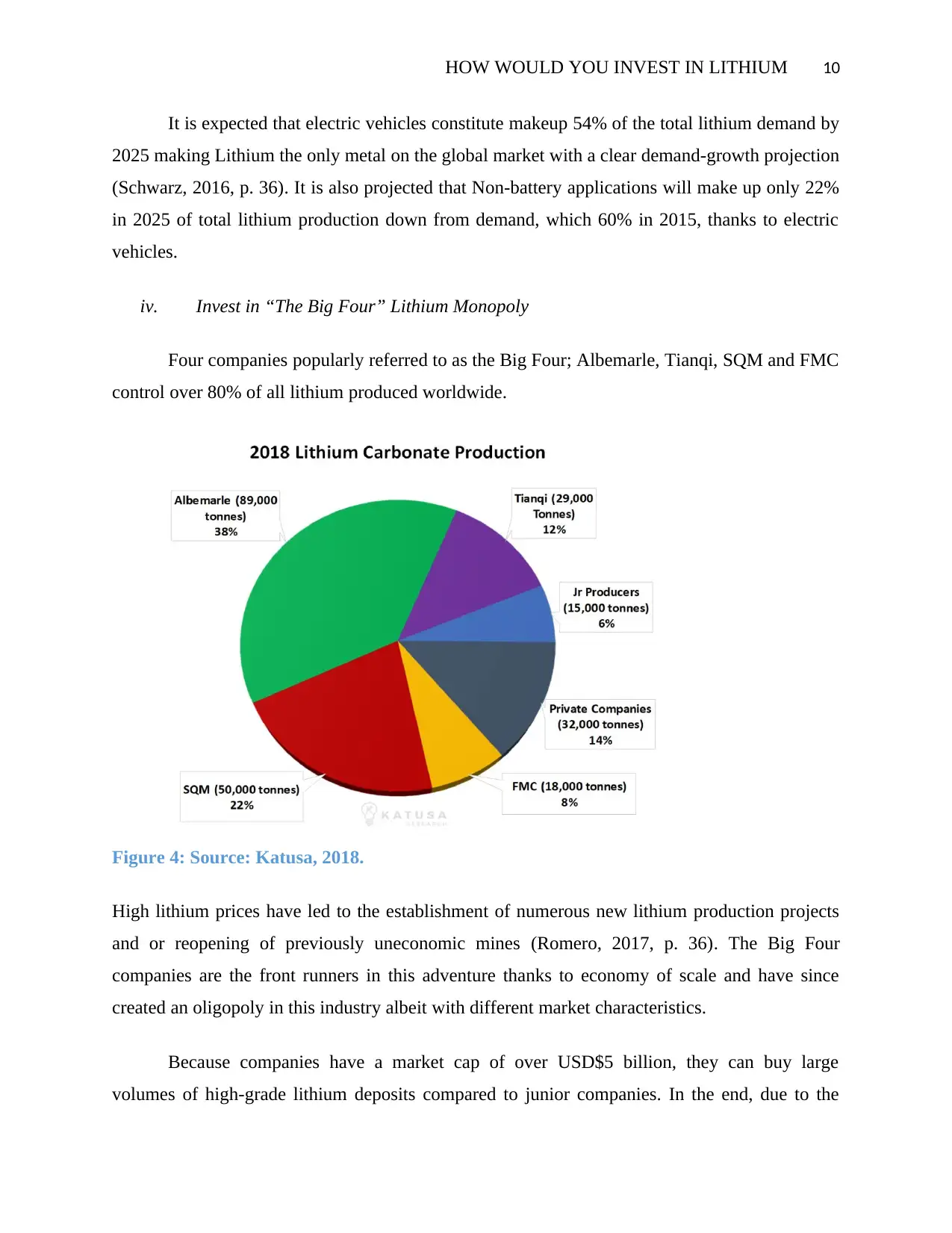
HOW WOULD YOU INVEST IN LITHIUM 10
It is expected that electric vehicles constitute makeup 54% of the total lithium demand by
2025 making Lithium the only metal on the global market with a clear demand-growth projection
(Schwarz, 2016, p. 36). It is also projected that Non-battery applications will make up only 22%
in 2025 of total lithium production down from demand, which 60% in 2015, thanks to electric
vehicles.
iv. Invest in “The Big Four” Lithium Monopoly
Four companies popularly referred to as the Big Four; Albemarle, Tianqi, SQM and FMC
control over 80% of all lithium produced worldwide.
Figure 4: Source: Katusa, 2018.
High lithium prices have led to the establishment of numerous new lithium production projects
and or reopening of previously uneconomic mines (Romero, 2017, p. 36). The Big Four
companies are the front runners in this adventure thanks to economy of scale and have since
created an oligopoly in this industry albeit with different market characteristics.
Because companies have a market cap of over USD$5 billion, they can buy large
volumes of high-grade lithium deposits compared to junior companies. In the end, due to the
It is expected that electric vehicles constitute makeup 54% of the total lithium demand by
2025 making Lithium the only metal on the global market with a clear demand-growth projection
(Schwarz, 2016, p. 36). It is also projected that Non-battery applications will make up only 22%
in 2025 of total lithium production down from demand, which 60% in 2015, thanks to electric
vehicles.
iv. Invest in “The Big Four” Lithium Monopoly
Four companies popularly referred to as the Big Four; Albemarle, Tianqi, SQM and FMC
control over 80% of all lithium produced worldwide.
Figure 4: Source: Katusa, 2018.
High lithium prices have led to the establishment of numerous new lithium production projects
and or reopening of previously uneconomic mines (Romero, 2017, p. 36). The Big Four
companies are the front runners in this adventure thanks to economy of scale and have since
created an oligopoly in this industry albeit with different market characteristics.
Because companies have a market cap of over USD$5 billion, they can buy large
volumes of high-grade lithium deposits compared to junior companies. In the end, due to the
Secure Best Marks with AI Grader
Need help grading? Try our AI Grader for instant feedback on your assignments.
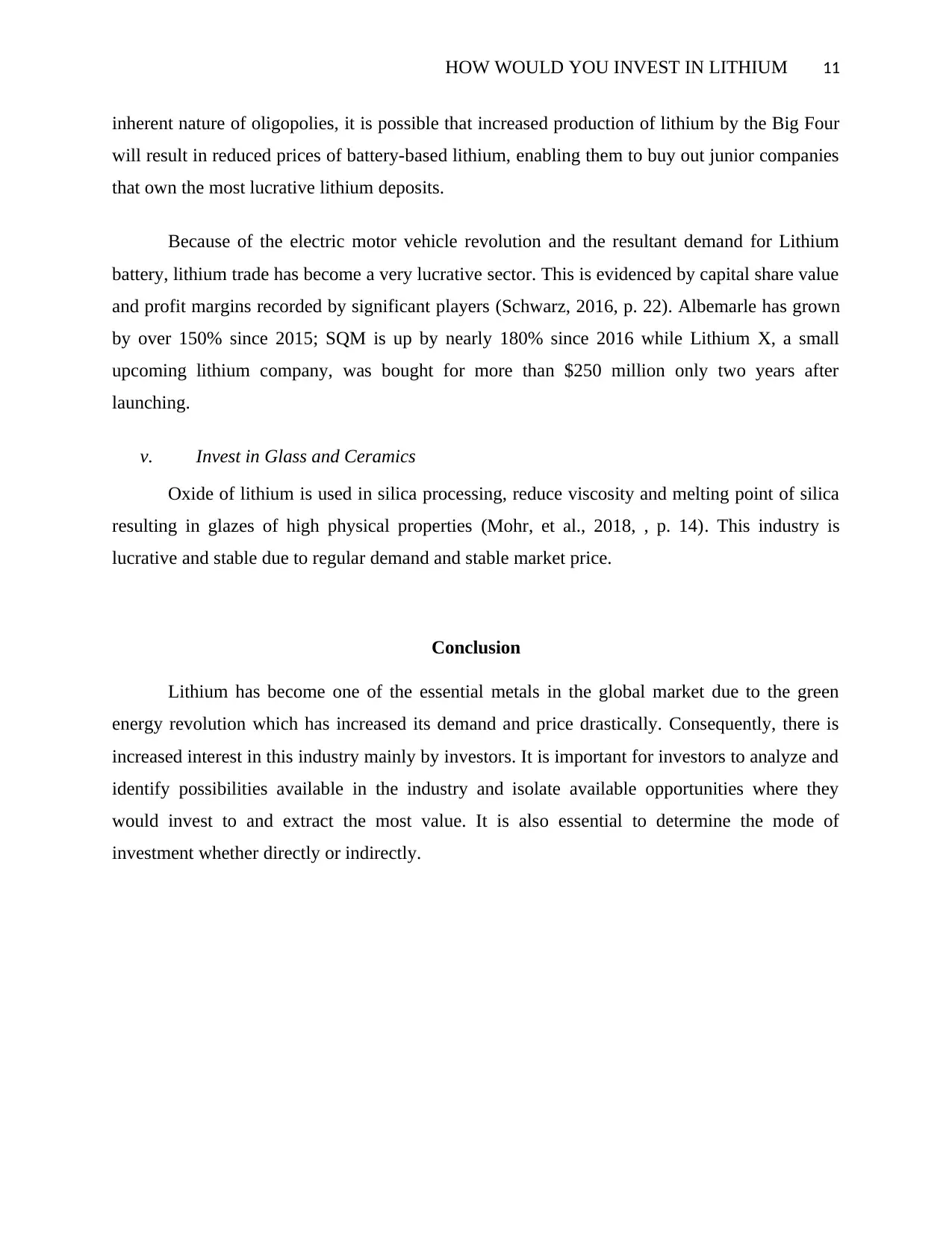
HOW WOULD YOU INVEST IN LITHIUM 11
inherent nature of oligopolies, it is possible that increased production of lithium by the Big Four
will result in reduced prices of battery-based lithium, enabling them to buy out junior companies
that own the most lucrative lithium deposits.
Because of the electric motor vehicle revolution and the resultant demand for Lithium
battery, lithium trade has become a very lucrative sector. This is evidenced by capital share value
and profit margins recorded by significant players (Schwarz, 2016, p. 22). Albemarle has grown
by over 150% since 2015; SQM is up by nearly 180% since 2016 while Lithium X, a small
upcoming lithium company, was bought for more than $250 million only two years after
launching.
v. Invest in Glass and Ceramics
Oxide of lithium is used in silica processing, reduce viscosity and melting point of silica
resulting in glazes of high physical properties (Mohr, et al., 2018, , p. 14). This industry is
lucrative and stable due to regular demand and stable market price.
Conclusion
Lithium has become one of the essential metals in the global market due to the green
energy revolution which has increased its demand and price drastically. Consequently, there is
increased interest in this industry mainly by investors. It is important for investors to analyze and
identify possibilities available in the industry and isolate available opportunities where they
would invest to and extract the most value. It is also essential to determine the mode of
investment whether directly or indirectly.
inherent nature of oligopolies, it is possible that increased production of lithium by the Big Four
will result in reduced prices of battery-based lithium, enabling them to buy out junior companies
that own the most lucrative lithium deposits.
Because of the electric motor vehicle revolution and the resultant demand for Lithium
battery, lithium trade has become a very lucrative sector. This is evidenced by capital share value
and profit margins recorded by significant players (Schwarz, 2016, p. 22). Albemarle has grown
by over 150% since 2015; SQM is up by nearly 180% since 2016 while Lithium X, a small
upcoming lithium company, was bought for more than $250 million only two years after
launching.
v. Invest in Glass and Ceramics
Oxide of lithium is used in silica processing, reduce viscosity and melting point of silica
resulting in glazes of high physical properties (Mohr, et al., 2018, , p. 14). This industry is
lucrative and stable due to regular demand and stable market price.
Conclusion
Lithium has become one of the essential metals in the global market due to the green
energy revolution which has increased its demand and price drastically. Consequently, there is
increased interest in this industry mainly by investors. It is important for investors to analyze and
identify possibilities available in the industry and isolate available opportunities where they
would invest to and extract the most value. It is also essential to determine the mode of
investment whether directly or indirectly.
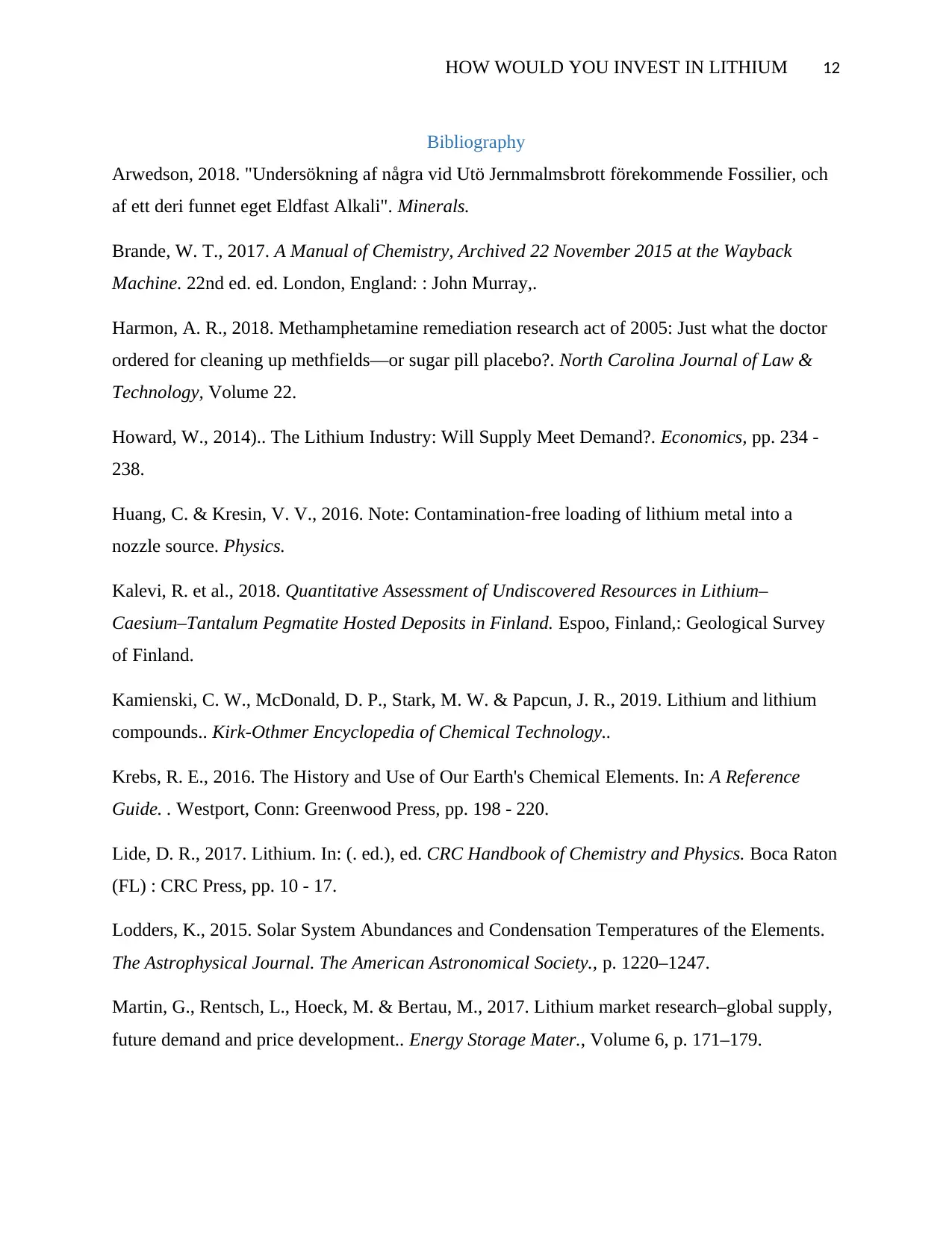
HOW WOULD YOU INVEST IN LITHIUM 12
Bibliography
Arwedson, 2018. "Undersökning af några vid Utö Jernmalmsbrott förekommende Fossilier, och
af ett deri funnet eget Eldfast Alkali". Minerals.
Brande, W. T., 2017. A Manual of Chemistry, Archived 22 November 2015 at the Wayback
Machine. 22nd ed. ed. London, England: : John Murray,.
Harmon, A. R., 2018. Methamphetamine remediation research act of 2005: Just what the doctor
ordered for cleaning up methfields—or sugar pill placebo?. North Carolina Journal of Law &
Technology, Volume 22.
Howard, W., 2014).. The Lithium Industry: Will Supply Meet Demand?. Economics, pp. 234 -
238.
Huang, C. & Kresin, V. V., 2016. Note: Contamination-free loading of lithium metal into a
nozzle source. Physics.
Kalevi, R. et al., 2018. Quantitative Assessment of Undiscovered Resources in Lithium–
Caesium–Tantalum Pegmatite Hosted Deposits in Finland. Espoo, Finland,: Geological Survey
of Finland.
Kamienski, C. W., McDonald, D. P., Stark, M. W. & Papcun, J. R., 2019. Lithium and lithium
compounds.. Kirk-Othmer Encyclopedia of Chemical Technology..
Krebs, R. E., 2016. The History and Use of Our Earth's Chemical Elements. In: A Reference
Guide. . Westport, Conn: Greenwood Press, pp. 198 - 220.
Lide, D. R., 2017. Lithium. In: (. ed.), ed. CRC Handbook of Chemistry and Physics. Boca Raton
(FL) : CRC Press, pp. 10 - 17.
Lodders, K., 2015. Solar System Abundances and Condensation Temperatures of the Elements.
The Astrophysical Journal. The American Astronomical Society., p. 1220–1247.
Martin, G., Rentsch, L., Hoeck, M. & Bertau, M., 2017. Lithium market research–global supply,
future demand and price development.. Energy Storage Mater., Volume 6, p. 171–179.
Bibliography
Arwedson, 2018. "Undersökning af några vid Utö Jernmalmsbrott förekommende Fossilier, och
af ett deri funnet eget Eldfast Alkali". Minerals.
Brande, W. T., 2017. A Manual of Chemistry, Archived 22 November 2015 at the Wayback
Machine. 22nd ed. ed. London, England: : John Murray,.
Harmon, A. R., 2018. Methamphetamine remediation research act of 2005: Just what the doctor
ordered for cleaning up methfields—or sugar pill placebo?. North Carolina Journal of Law &
Technology, Volume 22.
Howard, W., 2014).. The Lithium Industry: Will Supply Meet Demand?. Economics, pp. 234 -
238.
Huang, C. & Kresin, V. V., 2016. Note: Contamination-free loading of lithium metal into a
nozzle source. Physics.
Kalevi, R. et al., 2018. Quantitative Assessment of Undiscovered Resources in Lithium–
Caesium–Tantalum Pegmatite Hosted Deposits in Finland. Espoo, Finland,: Geological Survey
of Finland.
Kamienski, C. W., McDonald, D. P., Stark, M. W. & Papcun, J. R., 2019. Lithium and lithium
compounds.. Kirk-Othmer Encyclopedia of Chemical Technology..
Krebs, R. E., 2016. The History and Use of Our Earth's Chemical Elements. In: A Reference
Guide. . Westport, Conn: Greenwood Press, pp. 198 - 220.
Lide, D. R., 2017. Lithium. In: (. ed.), ed. CRC Handbook of Chemistry and Physics. Boca Raton
(FL) : CRC Press, pp. 10 - 17.
Lodders, K., 2015. Solar System Abundances and Condensation Temperatures of the Elements.
The Astrophysical Journal. The American Astronomical Society., p. 1220–1247.
Martin, G., Rentsch, L., Hoeck, M. & Bertau, M., 2017. Lithium market research–global supply,
future demand and price development.. Energy Storage Mater., Volume 6, p. 171–179.
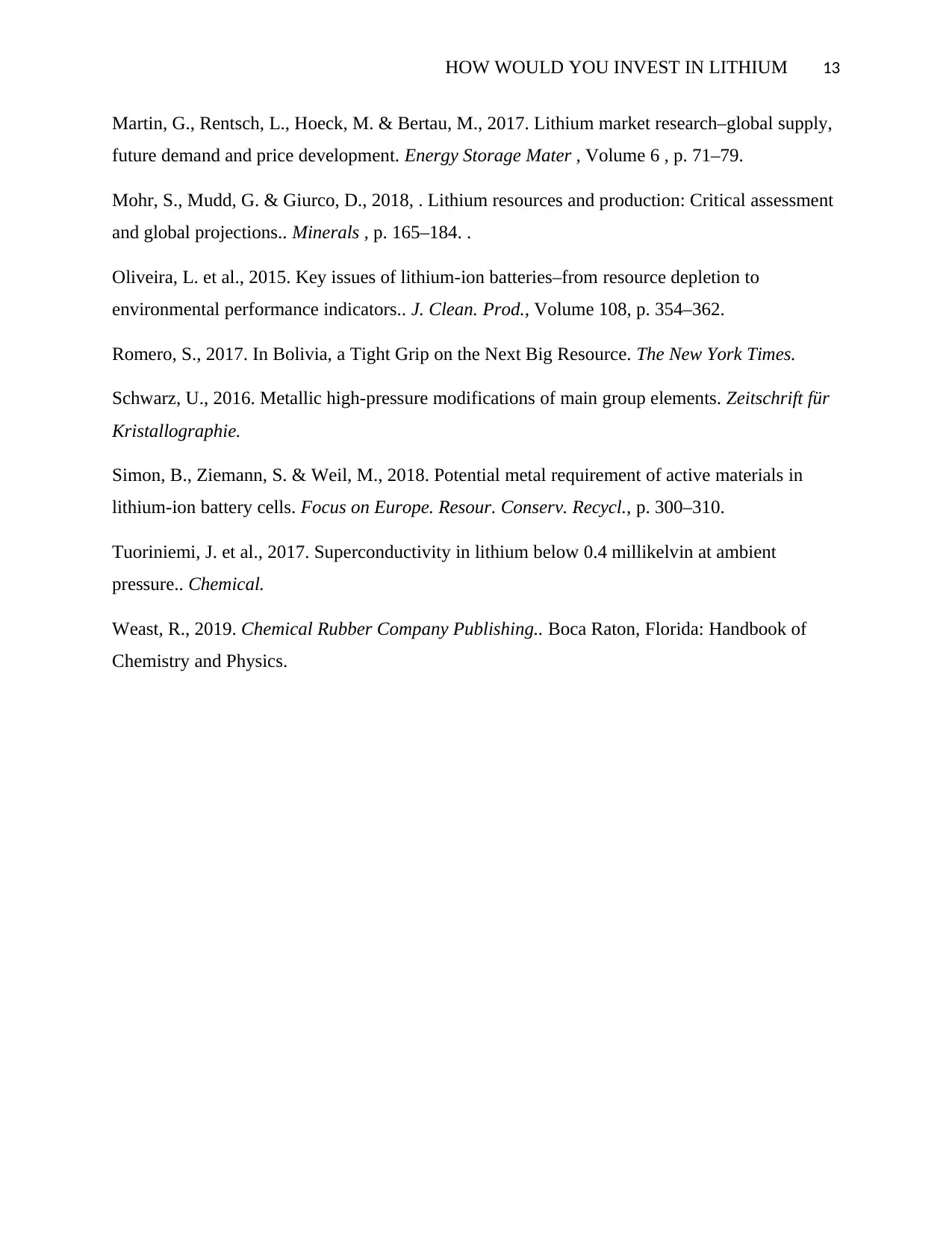
HOW WOULD YOU INVEST IN LITHIUM 13
Martin, G., Rentsch, L., Hoeck, M. & Bertau, M., 2017. Lithium market research–global supply,
future demand and price development. Energy Storage Mater , Volume 6 , p. 71–79.
Mohr, S., Mudd, G. & Giurco, D., 2018, . Lithium resources and production: Critical assessment
and global projections.. Minerals , p. 165–184. .
Oliveira, L. et al., 2015. Key issues of lithium-ion batteries–from resource depletion to
environmental performance indicators.. J. Clean. Prod., Volume 108, p. 354–362.
Romero, S., 2017. In Bolivia, a Tight Grip on the Next Big Resource. The New York Times.
Schwarz, U., 2016. Metallic high-pressure modifications of main group elements. Zeitschrift für
Kristallographie.
Simon, B., Ziemann, S. & Weil, M., 2018. Potential metal requirement of active materials in
lithium-ion battery cells. Focus on Europe. Resour. Conserv. Recycl., p. 300–310.
Tuoriniemi, J. et al., 2017. Superconductivity in lithium below 0.4 millikelvin at ambient
pressure.. Chemical.
Weast, R., 2019. Chemical Rubber Company Publishing.. Boca Raton, Florida: Handbook of
Chemistry and Physics.
Martin, G., Rentsch, L., Hoeck, M. & Bertau, M., 2017. Lithium market research–global supply,
future demand and price development. Energy Storage Mater , Volume 6 , p. 71–79.
Mohr, S., Mudd, G. & Giurco, D., 2018, . Lithium resources and production: Critical assessment
and global projections.. Minerals , p. 165–184. .
Oliveira, L. et al., 2015. Key issues of lithium-ion batteries–from resource depletion to
environmental performance indicators.. J. Clean. Prod., Volume 108, p. 354–362.
Romero, S., 2017. In Bolivia, a Tight Grip on the Next Big Resource. The New York Times.
Schwarz, U., 2016. Metallic high-pressure modifications of main group elements. Zeitschrift für
Kristallographie.
Simon, B., Ziemann, S. & Weil, M., 2018. Potential metal requirement of active materials in
lithium-ion battery cells. Focus on Europe. Resour. Conserv. Recycl., p. 300–310.
Tuoriniemi, J. et al., 2017. Superconductivity in lithium below 0.4 millikelvin at ambient
pressure.. Chemical.
Weast, R., 2019. Chemical Rubber Company Publishing.. Boca Raton, Florida: Handbook of
Chemistry and Physics.
Paraphrase This Document
Need a fresh take? Get an instant paraphrase of this document with our AI Paraphraser

HOW WOULD YOU INVEST IN LITHIUM 14
1 out of 14
Your All-in-One AI-Powered Toolkit for Academic Success.
+13062052269
info@desklib.com
Available 24*7 on WhatsApp / Email
![[object Object]](/_next/static/media/star-bottom.7253800d.svg)
Unlock your academic potential
© 2024 | Zucol Services PVT LTD | All rights reserved.
